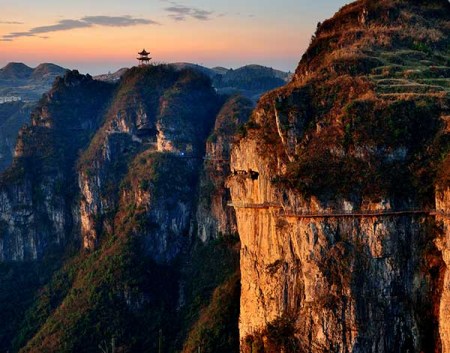
Passes built on the cliffs and a glass suspension bridge are among the highlights of Zhusha ancient town in Guizhou, which has turned from mercury mine site to a tourist hot spot. (Photo provided to China Daily)
The Zhusha ancient town in Guizhou province once produced mercury and vermilion, accounting for more than 80 percent of the nation's total output. Now, it plays host to tourists. Yang Feiyue and Yang Jun report.
An abandoned mercury mine is shaping up to be a tourism hot spot. The Zhusha ancient town in Wanshan district, Tongren city, in Guizhou province, which covers an area of 5 square kilometers, produced 33,000 tons of mercury and vermilion from 1950 to 2001, accounting for more than 80 percent of the nation's total output then.
But the local government, which shut the mine, is now focused on green development.
"Giving priority to the environment and pushing forward green development is the best way to transform," says Chen Changxu, a member of the National People's Congress and the Party secretary for Tongren.
The local government has made it a point to develop green spaces, and Zhusha has benefited from this policy.
While the local mines have long been shut, the area's natural environment and heritage are being used to develop tourism, says Liu Xianlu, a local official.
The area is now using its mining history to interest tourists.
It has a rare 970 km underground mining tunnel and a mass of natural vermilion.
The local government invested 2 billion yuan ($291 million) in 2015 when it started to develop tourism. Its goal was to build Zhusha into a resort featuring elements from the mining industry and leisure facilities, within three to five years. The refurbished town opened to the public in May 2016.
Now, a cliffside swimming pool and a glass suspension bridge have been built in the area, and attractions like a bar street and high-end hotels will be developed to improve the tourist experience, according to Liu.
Currently, many visitors come to get a glimpse of the mining days and to see Soviet-era structures, a town official says. A Russian restaurant is one of the highlights.
Meanwhile, the increasing popularity of the town has brought about positive changes in the lives of the locals.
One of them is Huang Yaping, who had to leave home with her husband to make a living after the mercury mine went bankrupt in 2001.
"Many of my colleagues left after the mine was shut," says Huang.
There were more than 30,000 people in the town when the mine was at its peak.
Huang returned to the town in 2008 and has run a small grocery business ever since.
Recounting her early struggles when she returned, she says: "First, we could barely keep our heads above water, but as our parents were getting older we could not work away from home."


















































